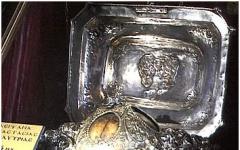The arrangement of internal partitions made of brick is considered a traditional, “classical” way of constructing such structures.

When laying bricks next to the door frame in a row, it is necessary to lay L-shaped brackets.
They are characterized by durability, strength, and a high degree of fire resistance.
The mineral nature of the material provides a high level of sound insulation, and the absence of cavities does not allow rodents to infest. The downside is that such a structure has a considerable weight, and laying brick partitions is considered a “wet” job involving the use of cement mortar.
Features of construction

Rules for laying out bricks: a - 2.5 bricks, b - 1.5 bricks, c - 1 brick; 1 - for the tychkovy verst, 2 - for the spoon verst.
In order to somehow smooth out the main drawback, the partitions are usually placed in half a brick (12 cm) or on an edge (the resulting thickness is 6.5 cm). Hollow bricks are also sometimes used, but then the quality of sound insulation decreases.
Installation of structures is carried out before the installation of a cement screed. To ensure maximum stability and adhesion to the building, metal reinforcement is inserted into the floor slab (base) by drilling, which is then secured in the vertical seam of the partition.
In some cases, it is possible to attach to the ceiling using metal profiles and dowels. It is necessary to level with cement mortar the part of the base on which the partition will rest. It is undesirable in places with high humidity, since it does not have sufficient resistance to its effects. After erecting the partition, the surface must be plastered.
The thickness of only 12 cm makes it necessary to take additional measures to strengthen the brick structure. Reinforcement is usually used: after 4-5 rows, metal reinforcement or fine mesh is placed in a horizontal seam, the ends of which are inserted into one of the main structures of the building or secured with dowels. If it is long, then additional vertical reinforcement is used with the help of rods and mesh, passed through the seams and fixed at the base. Particularly difficult is the construction of a partition less than 12 cm thick, that is, “on the edge” of a brick. Such a structure is very shaky, so construction is usually carried out in stages, with the construction of 4-5 rows and their subsequent drying.
Preparatory work

The general construction plan indicates all partitions, their sizes, as well as methods and materials of fastening to load-bearing walls.
At the first stage, it is necessary to take measurements of the future partition in order to calculate the required amount of brick. The brick structure can have a thickness of 12 or 6.5 cm (the stone is placed on its edge). The dimensions of a standard brick are 250x120x65 mm; when calculating, take into account the thickness of the mortar joint, which is 12 mm.
To build a structure at a height, you will need trestles, which can be made from available materials - boards, bars. You can also make a container for mixing the solution (if you don’t have one) yourself - to do this, take a 200-liter steel barrel and cut it lengthwise with a grinder. All that remains is to place the bars for stability - and you can knead!
The solution requires high-quality sand. You can use regular one, after sifting it first. To do this, use a metal mesh; fits well with the old, “Soviet-style” bed. In addition to bricks you will need:

The partition in the brick floor must be additionally secured at the junction of the load-bearing walls.
- cement (grade not lower than M500);
- water;
- mason's hammer ("pick");
- trowel or trowel;
- reinforcing bars or fine mesh;
- dowels or metal profile for attaching a 12 cm thick brick partition to the base;
- building level, plumb line;
- rule (well-planed strip 1.5-2 m long);
- nylon cord.
If necessary, plastic additives can be purchased to add to the solution. They can prolong the “workability” of the mixture or ensure its quality at low air temperatures. The door frame is installed in advance and fixed with spacers.
Construction of a brick partition

When laying masonry, a nylon cord (order) is usually pulled so that the masonry is carried out strictly horizontally.
Prepare the base: clean it down to the floor slab. If there is plaster on the walls, it must be knocked down. Clean the surface to which the partition will adjoin with a broom from dust and moisten with water. Place the brick so that it can be easily reached without getting in the way.
- First you need to mix the solution at the rate of 3 parts cement and 1 part sand. To do this, pour both ingredients into a half-barrel and mix dry with a shovel. Then make a funnel in the middle and add water there, mix everything. The finished mixture should resemble the consistency of good sour cream. The solution dries quite quickly, so mix it for no more than an hour of work. If the mixture begins to harden, simply stir it (it is not recommended to add water).
- In the place where you plan to lay the first row of a 12 cm brick partition, pull a nylon thread. Using it as a guide, place the mortar (its strip should be a little wider than necessary) and bricks on it. They must be carefully leveled. The first row should be as horizontal as possible.
- When laying bricks next to the door frame in a row, it is necessary to lay L-shaped brackets that will fix the frame in the desired position. Laying is carried out in compliance with the order, i.e. the vertical seams should not coincide. Bandaging allows you to make the wall monolithic.
- After the laying of the 1st row is completed, proceed to the second. To do this, pull the cord and lay out a row along it. Check each laid stone with a building level, as a rule, and starting from the 3-4th row, use a plumb line to check verticality.
- Every 3-4 rows it is necessary to carry out reinforcement using a fine mesh. Its fastening is carried out using dowels nailed to the walls. As a lintel over the doorway, you can use a channel or a wooden block wrapped in waterproofing material (for example, roofing felt).
- When the brick wall reaches the ceiling, a small gap will remain. To fill it, you can use fragments of broken bricks, which must be covered with mortar. During work, constantly monitor verticality using a plumb line and horizontality using a level; Then it will be very difficult to correct the flaws.
After the laying of the 12 cm brick partition is completed, you can immediately begin plastering the surface. If it was used, then during the work the mason must open the seams with a special tool. If you intend to carry out any communications, then you should acquire in advance sections of metal pipes of suitable diameter and length. The resulting gap is best sealed with foam. Before the solution in the partition has more or less set (7-10 days), the wall cannot be touched.
Basic rules for the construction of partitions
- Sometimes a 12 cm brick partition is laid to achieve the best sound insulation with the aim of constructing a double wall with an air gap. For the same purposes, roofing material (double layer) is laid over the ceiling. Even better results can be achieved if you use a cement-sand mortar to install one of the walls, and a lime-cement mortar for the other.
- If the partition of 12 cm is small or the stone is placed on its edge, then it is possible to use templates according to which the first couple of rows are laid out.
- Before installation, the door frame must be treated with antiseptic and fire-resistant compounds.
- If 12 cm brick partitions are installed in a new house, then it is better to install the mortgages for attaching them to the walls in advance.
Brick walls freely allow the mounting of any shelves, cabinets and equipment. A well-laid partition will not only fulfill its main function, i.e., divide the living space, but also provide good sound insulation between the individual parts of the room and comfortable living.
A brick partition is designed to divide one room into several in order to increase their fire safety, sound insulation or change functionality. It has high strength and load-bearing capabilities, so it is possible to lay communications inside or on the surface: pipes, electrical wiring, communication cables.
Perform the following functions:
- Soundproofing, which will reduce acoustic and structural external noise indoors.
- Thermal insulation, in the case of using insulation with the necessary technical characteristics.
- Fire-resistant, preventing the spread of fire for a certain time.
- Departments of rooms with high humidity (bathrooms and kitchens) and/or temperature (workshops, boiler rooms).
The nuances of constructing a partition
Brickwork creates a load of several hundred kilograms per linear meter (depending on thickness and height). Therefore, it is important to make sure that the structure being built will have a reliable foundation:
- in private houses, an auxiliary foundation is provided at the design stage;
- in multi-storey buildings, installation is allowed only on reinforced concrete floors if the total weight is significantly lower than the maximum loads.
Installation of the partition is possible in accordance with the requirements of SP 15.13330.2012:
- the thickness of the ceiling made of stone or concrete is at least 12 cm, from reinforced concrete - from 6 cm;
- room height up to 6 m;
- the thickness of the load-bearing walls is more than 12 cm.
If the maximum height exceeds 6 m, then such a structure is considered self-supporting and is subject to more stringent requirements for technical parameters and materials used.
Suitable Brick Types
Interior partitions can be erected using the following types:
- Ceramic, with high tensile strength and resistance to moisture. Available in full and hollow, a wide range of colors and textures are available. Its disadvantage is the possible appearance of salt deposits on the surface.
- Silicate, characterized by low cost, optimal strength characteristics, frost resistance and durability. Disadvantages include high moisture absorption and weight.

The use of ceramic blocks is beneficial for the construction of structures with unique decorative properties, when it is necessary to minimize the load on the base, for the purpose of operation in conditions of high moisture. It is appropriate to erect silicate partitions in residential and utility rooms with a large margin of safety of the floors, as well as in cases of a limited budget.
The construction of non-load-bearing walls will be simplified, and the service life will be as long as possible when choosing bricks of the appropriate quality that meet the requirements of SP 15.13330.2012:
- deviations in length and width – no more than 4 mm, and in height – up to 2 mm;
- maximum curvature of block geometry (faces and edges) – up to 3 mm;
- The presence of chips, cracks, salt deposits and other defects is not acceptable.

Brick laying methods
The minimum wall thickness must be more than 60 mm. It is permissible to use the following schemes:
- on edge (65 mm), allowing maximum savings on construction and saving room space;
- half a brick (120 mm), thanks to which you can get a strong and reliable wall with high load-bearing capacity.
Reinforcement of walls and partitions made of bricks when placing them on edge or installing communications and suspended structures is mandatory. This is due to the need to distribute the load evenly and avoid destruction.
Reinforcement is carried out with steel rods with a diameter of 2-6 mm or mesh with cell sizes from 30x30 to 60x60 mm. It is recommended to place them evenly at intervals of 4-5 rows. In this case, the reinforcing layer is securely attached to the load-bearing walls and floor with dowels or inserted into them to a depth of at least 8-10 cm. If it is planned to apply plaster, then the metal elements are made to protrude beyond the masonry by 2-3 mm.
Reinforcement with rods and mesh is carried out according to the principle of creating butting seams, the thickness of which should be 2 mm greater than the diameter of the metal layer. They are selected so that cement consumption is minimal and the brick partitions have sufficient strength.

How to achieve the required level of sound insulation?
Sound insulation allows you to ensure an optimal acoustic environment in the premises. Therefore, structures must be designed and constructed taking into account the following requirements:
- a structural rigid decoupling from load-bearing walls and ceilings is required using special soundproofing membranes, as well as fastening elements;
- the thickness of the partition should be as large as possible, and the structure itself should be more massive; the presence of cracks and any other defects is not allowed;
- The use of soundproofing materials is recommended.
Properly executed sound insulation of a structure with a thickness of 150 mm allows you to achieve a level of airborne noise absorption of up to 47 dB.

How to increase fire resistance?
Depends largely on the selected block type:
- ceramic interior partitions retain fire resistance up to +900°C, they do not melt, crumble or crack after a fire, but they will not withstand repeated fire and will collapse;
- silicate brickwork retains its structure at temperatures up to +700°C, but above this value the performance characteristics deteriorate and embrittlement occurs.
Fire resistance must be taken into account in the construction project and implemented constructively, since if errors are made, they are technically quite difficult to correct. A 65 mm wall can withstand a fire for 45 minutes, and a 120 mm wall can withstand fire 4 times longer. If the construction was made from hollow blocks, then the indicator is reduced by 0.5 and 1 hour, respectively.

You can improve the indicator like this:
- reinforcement using refractory steel;
- Concreting or plastering external surfaces;
- using protection with fire-resistant coatings or layers;
- the construction of partitions should be carried out with the installation of mineral wool heat-insulating materials;
- the brickwork must be made so that the cross-sectional thickness is greater and provides the required level of fire safety.
Fire resistance also increases if the construction of the wall does not involve the use of highly flammable and combustible materials.

Technological features of masonry
The following features of the laying of partitions are distinguished:
1. installation of bricks is carried out at temperatures above +5°C;
3. the solution requires the use of cement grade M400;
4. reinforcement of the lower and upper layers is performed with rods with a diameter of 6-8 mm;
5. the height of the seams should be the same;
6. Laying rows is carried out in 3-4 rows, after which the work is interrupted until the solution sets;
7. all stages of work must be accompanied by mandatory control of the evenness of the rows;
8. if the height of the last row is less than the size of the brick, then the space is filled with cement mortar using reinforcement;
9. If sudden temperature changes may occur in the premises, then it is necessary to use expansion joints at points of contact with load-bearing walls.
Very often, in order to divide the space into certain zones, brick partitions are erected, which must fully comply with the standards prescribed by SNiP.
Of course, laying brick partitions should be done by professionals, but if you correctly master the technology and know the requirements of SNiP, then all the work can be done with your own hands.
Such brick partitions are often used in apartments to divide large spaces into smaller ones.
In addition, they are made in the bathhouse, as well as in a number of other facilities.
In all cases, unified fire safety standards and other requirements specified in SNiP have been developed for brick partitions.
Such a partition does not serve as a load-bearing wall, however, if all rules and requirements of SNiP are observed, it has sufficient strength, good moisture resistance and can provide optimal sound insulation.
For different spaces in which it is planned to erect a brick partition, a different brand of material to be used is selected, as well as the thickness of the future structure, and all this is regulated by SNiP.
Despite the fact that laying brick partitions is quite a responsible job, with the appropriate approach it can be done with your own hands. The main thing is to comply with the requirements specified in SNiP.
This is described in more detail in the video below.
In most cases, partitions made of brick are subject to two requirements, namely, they must be reliable and durable.
Structures of this type are constructed upon completion of all major construction work, following all SNiP requirements.
Due to its fairly large weight, there must be a foundation under it, and in addition to this, reinforcement must be made.
Also, certain fire safety standards have been developed for this type of partition; there are recommendations that regulate the thickness of the future wall, the brand of brick used and other requirements.
If a wall separating the space is being built in a bathhouse, then solid red brick should be used. For partitions in the apartment, you can use gas silicate and foam concrete blocks.
The thickness of the finished wall should be at least 10 centimeters. If there is no additional load on the wall, then the brick can be laid on its edge.

When building partitions with your own hands in a bathhouse, apartment or any other space, it is necessary to monitor the absence of cracks and crevices.
You should also be sure to monitor the level of the wall under construction and this can be done most easily using a stretched cord.
Attention should also be paid to the quality of the cement mortar, which should be elastic, but not liquid.
If you plan to erect partitions in a newly built house, then it is better to do this six months later, after the foundation has completely settled.
Sequence of work
For the construction of partitions, both in a bathhouse and in an apartment, regardless of its type, a number of recommendations have been developed, which can be found in SNiP.
When building them in an apartment or bathhouse, the brick is most often placed on its edge. This type of partition in a bathhouse or apartment allows you to save a little on material, but its thickness will be minimal.
First of all, the foundation should be prepared for work. A layer of special film or roofing material must be laid on the foundation.
In the video below you can see how to lay a brick on its edge.
After the foundation has been prepared, according to pre-made markings, the first layer of mortar is applied, the thickness of which should be the same. After this, the brick itself is laid on top of the edge.
The solution should be evenly distributed over the entire surface of the stone.
To vertically control the wall being built, a string should be pulled between the walls, which will need to be moved upward as the partition grows.
After the first row of bricks has been laid, the next one is laid on the edge in the same way, as shown in the video above.
After the construction of several rows of masonry, in which the brick is placed on its edge, the future wall should be reinforced. To perform reinforcement, it is necessary to drive metal pins into the adjacent wall, and then bend them into the masonry joint.
Reinforcement should be done after the construction of every fourth row of masonry. It is imperative to follow the rules for ligating sutures.
When laying a brick on an edge, only a vertical bandage is made, which implies when placing a brick on an edge that its vertical seam should be opposite the middle of the bottom stone.
The process of laying a brick partition with your own hands is shown in detail in the video below.
Quite often there is a need to construct partitions from a special type of brick. For example, in some individual cases it is recommended to make fire partitions in a bathhouse yourself.
It will help prevent the spread of fire in a critical situation.
There are several types of fire partitions, but in private construction, fire partitions of the first type are most often used.
The thickness of the first type of partitions must be at least ten centimeters, and only fire-resistant bricks and finishing materials must be used.
Due to their fairly large weight, fire barriers should be constructed with a foundation and reinforced.
To equip the foundation for fire partitions of the first type, it is necessary to reinforce it and wait a certain time so that the foundation fully gains strength.
Fire partitions are built according to the conventional principle, although their recommended thickness should be at least one brick.
When building a dividing wall in an apartment, experts advise making it as thick as half a stone. M100 brand bricks with standard dimensions are excellent for these purposes.
If the future wall will have a length of about three meters, then you should not make masonry higher than one meter in one day.
This is mainly due to the fact that the solution must rise and strengthen, otherwise the partition may simply fail.
Upon completion of the work, the wall should be given time for the solution to completely harden and only after that can you proceed to plastering and finishing work.
Before laying the brick into the masonry, it should be wetted. This will help avoid excessive absorption of moisture from the solution and accordingly increase its strength and ductility.
Work on the construction of brick partitions in a bathhouse or apartment, subject to all requirements and recommendations, can be done with your own hands.
In this case, it is necessary to have all the necessary tools on hand, use only high-quality building materials and follow the work order.
When carrying out work (reinforcement, bricklaying, etc.), you should not rush. After each stage of work, time should be given for the solution to harden and set. This will make the wall being built stronger and more even.
Indeed, a huge amount of information can be found about brick as a building material. But it is not enough to have this information; you need to be able to use it wisely. Of course, for most developers, brick is synonymous with good quality, solidity, strength and comfort. That is why it is often preferred when constructing not only load-bearing structures of a house, but also interior partitions. There are currently a great variety of materials for the construction of internal structures, but if the owners want to be sure of the strength of the structure, its durability and reliability, they still choose brick. This is especially true for stationary partitions, which will remain unaffected during future redevelopments. Brick is also used if special requirements are placed on the insulation of a room, which is why this material is often used to separate plumbing rooms. However, in fairness, it should be noted that not every type of brick will protect you from the murmur of water from a filling bath, etc. And not everyone will provide you with the proper peace and quiet.
What exactly is the matter?
And what else do you need to know about brick, so that after the construction of the interior partition you do not lament the mistakes made and do not regret what you have done? In order to answer this question, you need to have some ideas about the nature of sound and understand that noise has two types: structural and airborne. The first is transmitted through structures, and the second through air vibrations. It is this definition that completely refutes the myth that hollow brick is an excellent material for the construction of internal walls. It's a delusion.
Selecting a material based on soundproofing properties
Undoubtedly, interior partitions made of brick are quite a heavy structure and, wanting to lighten it, many began to use a variety of this material with voids. It is understandable that the specific gravity of solid brick is 1800 - 1950 kg/m3, and that of hollow brick is 1200 - 1650 kg/m3.
However, voids in the product, which greatly increase thermal conductivity, do not work at all as sound insulation. Moreover, the cavities in the brick play the role of a resonator and perfectly transmit the structural component of noise.
The simplest and most reliable way to eliminate this problem is by increasing the density of the separating structure. In order to reduce the resonating properties of the product and sound absorption, it would be necessary to fill them with bulk material, which inevitably led to an increase in weight.
Yes, such a brick is good for cladding external walls, but it is not recommended for interior partitions. Currently, with the increased interest of developers in the soundproofing properties of building materials, some manufacturers have begun to indicate noise absorption parameters in the list of characteristics.
Sometimes they coincide with reality, but most often it is prescribed in what is called “Lazarus at random,” adjusting the numbers to the requirements of sanitary and hygienic standards. Unfortunately, the deception is exposed only after construction and repair work is completed.
Finding the truth in this case is quite difficult, but, nevertheless, it is worth stocking up on some information.
Everyone already knows the Rw indicator of 43 dB; this is the noise insulation coefficient that a material must have to protect against household sounds.
For comparison, some data are summarized in Table 1.
Table 1
Against the background of the data presented, the indications stated by some manufacturers, such as porous brick δ 115 mm with Rw 52 dB, seem very suspicious. Agree, such values may give rise to some thoughts.

The next, not very successful example of reducing the mass of a structure is laying bricks on an edge. Of course, the difference is noticeable if, when erecting a half-brick wall, it will take you on average per square meter
10000 cm2/(6.5+1cm x 12+1cm) ~ 103 pcs.,
Accordingly, its mass will be about 360 kg, and a quarter of a brick
10000 cm2/(25+1cm x 12+1cm) ~ 30 pcs., weight per square meter 105 kg,
Where +1cm is taking into account the width of the seam. Plus plaster, but we don’t take its weight into account, since it will be approximately the same in both cases. Did you feel the difference? And if we have found out that the ability to absorb structural sound directly depends on the mass of the separating structures, judge for yourself which of them is more reliable.
Brickwork, reinforced mesh
No, if the purpose of the wall is purely decorative and not functional, then please. But if you plan to get an isolated room as a result of reconstruction, then we do not recommend using the method of laying bricks on an edge. Not only does a wall thickness of a quarter of a brick - 65 mm, not provide high-quality sound insulation, its strength characteristics also do not inspire confidence, especially if the wall size exceeds 2.5 meters, both in length and height.
It is worth noting that the construction of such a structure requires a lot of diligence and patience. Due to the small size of the support, quarter brick masonry is very unstable and according to all the rules, only 5 - 7 rows can be laid per day.
Then you need to give time

so that the masonry mortar “sets” and gains a certain strength, after which you can begin to continue work. Due to the vulnerability of the structure in the first hours, masonry is often carried out using guides, which will require additional time and money.
To speed up the process and more complete hydration of the cement-sand mortar, fresh masonry is covered with insulating material. This is necessary in order to maintain the humidity regime, and in winter to prevent the access of cold air.
To briefly summarize the above, it follows that for the construction of interior partitions it is recommended to use solid products with half-brick masonry technology.
And a little about the quality characteristics of bricks. To carry out construction work indoors, preference is most often given to ceramic bricks, this is explained by the best indicators of moisture resistance, strength in a saturated state and air permeability. This is really very important, especially when constructing partitions to separate sanitary facilities: toilets, baths and saunas.
The algorithm for installing self-supporting brick walls differs little from the construction of partitions from other materials. First of all, markings are applied on horizontal and vertical surfaces indicating the width of the future wall and indicating doorways.
Then work on preparing the solution, it is mixed according to a certain recipe, depending on the brand of the main component - cement and the required brand of masonry mixture. As a rule, Portland cement is purchased M400 and M500, and the most common grade of mortar is M50 and M75. The C:P ratio by weight of the simplest recipes is presented in Table 2.
table 2
Mortar brand/Cement brand | ||
To give the solution plasticity and workability, surfactants and air-entraining additives are introduced into the mixture; their permissible percentage content is always written on the packaging. Natural materials, lime paste or clay are also used as plasticizers, but this practice is becoming less and less common in modern construction.
The water-cement ratio also plays an important role in mixing the mortar; it varies between 0.4 - 0.7. Those who have tried to adjust the plasticity of a solution with the amount of water know how the setting time is delayed as it increases, so you should not abuse this technology.
Indeed, the mobility of the mortar for laying solid bricks should be slightly higher than, for example, for hollow or porous bricks. But it is better to achieve the required workability by adding plasticizing compounds. In order for the water to remain in the solution longer, I recommend pre-wetting the brick with water.
After applying the markings and preparing the solution, you can proceed directly to the masonry itself. The first is a leveling layer, which allows you to eliminate surface defects and bring the zero level. Then the first row is laid; the quality of the partition’s construction depends on how correctly this stage of work is completed. Therefore, it is so important to comply with all requirements for straightness in the horizontal and vertical plane. The check is carried out using a level, plumb line and rules. Subsequent rows are laid offset so that the vertical seam of the previous row is located in the middle of the brick of the next row (Fig. 1).
Some minor flaws in the masonry can be eliminated by lightly tapping through the “foreign” one; this must be done before the solution “sets.” This happens as follows: after laying several rows, a flat strip is applied to the surface of a section of the wall and it is tapped with a hammer or pick until there is a complete fit along the entire length of the measuring tool. The procedure is repeated, changing the position of the slats clockwise.
The laying of each subsequent row begins with the installation of a cord - a mooring; it serves as a guide for alignment in the rows.
Masonry with internal reinforcement
If plastering of the surface is planned in the future, then the entire masonry is done without filling the seam. In this case, the adhesive properties of the surface increase many times over. If finishing work is not expected, and in modern design this direction is very popular, then it is necessary to perform the facing masonry with the same width of the seams and their subsequent jointing. For decorative masonry, you can use colored masonry mortars, which are prepared by adding various pigments to the mixture.

The next point that requires close attention is tying the inner wall to the main structures and strengthening its load-bearing capabilities through reinforcement.
The rigidity of the junction is ensured by anchors that are installed in the load-bearing wall at intervals of 5–6 rows. You can also use a perforated metal mounting strip. It is made in the form of a corner with holes, one of its shelves is attached to the main wall with a dowel, and the other is placed between the rows of the masonry. Thus, a connection appears that connects the two walls to each other, but at the same time the load of the interior partition is not transferred to the supporting structure.
The partition is strengthened through reinforcement; for this, both individual rods with a diameter of 6–8 mm and wire mesh with a diameter of 4 mm are used (Fig. 2).
The reinforcing elements are laid vertically and horizontally, so their intersection forms a frame, the recommended cell size is 525mm x 525mm. The total diameter in places where reinforcement crosses should not exceed the width of the seam, minus 5 mm, which provides a protective layer to the metal structure. If the length of the partition is less than 1.5 m, then reinforcement is permissible only in the horizontal section.

The arrangement of doorways also has its own nuances. Their configuration can have various shapes, rectangular and arched. There are two ways to install a door frame; in the first option, the wooden structure is put in place after applying a leveling layer. It is necessary to provide spacers inside the frame that will prevent deformation during the laying process. When using the second method, you need to have the ideal dimensions of the opening in the wall and the door frame, since its installation is carried out after the completion of construction work.
In the upper part of the rectangular opening, a reinforced concrete lintel, type PB, is laid. They are produced in a variety of sizes, so you can always find the right option.
For a structure in the form of an arch, you will need to make a template of the radius that interests you and, after installing it, complete the laying of the doorway.
It is difficult to calculate that the top row fits clearly between the partition; often there is a gap left, which is filled with halves and quarters of bricks, previously coated with mortar. That's it, the construction of the interior partition is completed. Finishing work can only begin after the cement-sand mixture has gained strength, otherwise there is a risk of deforming or damaging the structure.









